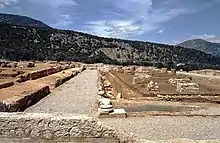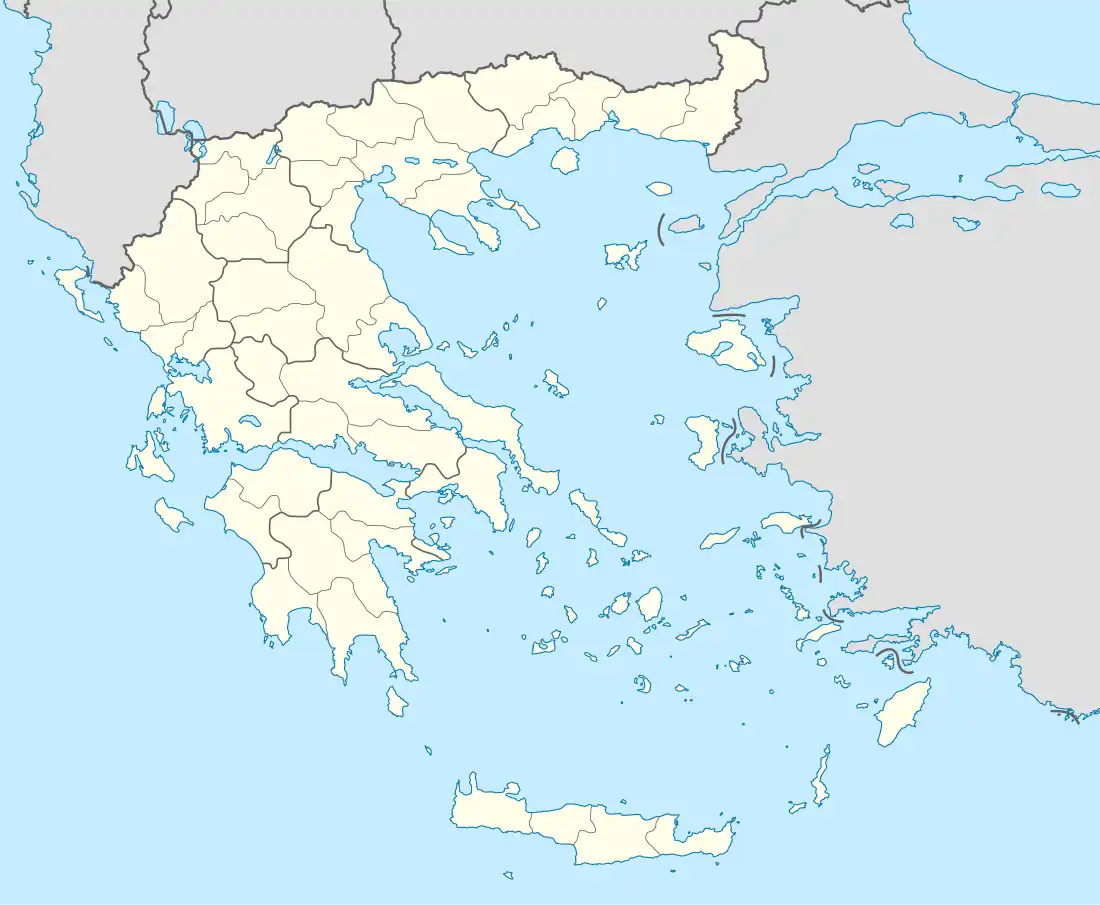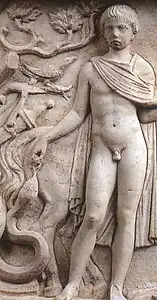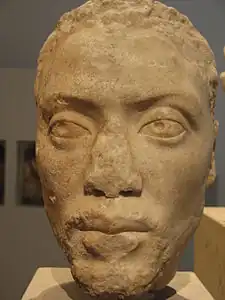Villa of Herodes Atticus
Villa of Herodes Atticus is an ancient Roman villa located on the outskirts of Doliana and near Astros in Arcadia, Greece.[1][2]
Έπαυλη του Ηρώδη του Αττικού | |
 | |
 Shown within Greece | |
| Location | Doliana, North Kynouria, Arcadia, Greece |
|---|---|
| Region | Peloponnese |
| Coordinates | 37.415959°N 22.685469°E |
| Type | Villa |
| History | |
| Founded | 2nd century AD |
| Associated with | Herodes Atticus |
| Site notes | |
| Excavation dates | 1978 |
| Archaeologists | Georgios Steinhauer, Panagiotis Faklaris |
It was near the ancient city of Eva.
It was developed between the 1st and 5th centuries by the family of Herod Atticus, a Greek rhetorician famous for his fortune and his actions of public patronage. The villa is one of the main vestiges of Roman villa architecture in Greece.
History
The site, near the Argolic Gulf and bordering the Tános River, belonged in ancient Greece to Thyrea.
The family villa of Herodes Atticus
The first villa was erected in the 1st century probably by his father Tiberius Claudius Atticus Herodes, ex-praetor, provincial priest, then consul suffect in 133 AD. However, it is likely that the land was purchased by Herodes Atticus' grandfather, Tiberius Claudius Hipparchus.
Herodes Atticus carried out major extension work on the estate, giving it the grandeur and luxury of a rich patrician residence. The archaeological remains offer proof of a second phase, around the year 165, when overwhelmed by the loss of his wife Régilla and his sons, he covered the villa with artistic works of his relatives. In particular, he had the heroon of Antinous converted into a sort of funerary triclinium, placing several cenotaphs in the room as well as in the nymphaeum. Several stelae and a herm also testify to a heroic cult towards his adopted sons.
The estate remained active at least until the 4th century and even until the following century, probably still in the family, maintaining close ties with Rome.
Destruction and reuse
The property was partly destroyed at the end of the 4th century, potentially by an earthquake or the Visigoth invasions. At the beginning of the 5th century the baths and other parts of the villa were used for craft productions and the north wing modified to create a large basilica. The imposing monument however collapsed a few centuries later, probably following a major earthquake in 856.
The Monastery of the Transfiguration, dating from the 12th century and located 250 m south of the villa, now houses many ancient artifacts most likely from the domain of Herodes Atticus. Remains of the Roman villa were integrated into the masonry. Traces of activity during the Byzantine, Ottoman and modern periods have however been brought to light during excavations.
Rediscovery and modern excavations
The site was rediscovered in 1809 by British traveler William Martin Leake. He thought he saw, in the remains of a wall, the Hellenistic enclosure of ancient Thyrea. About forty years later, the German archaeologist Ernst Curtius refuted the idea of an urban wall in favour of Roman domestic use, without making any connection with Herodes Atticus. It was not until 1906 and the work of Konstantínos Rhomaíos that the villa became associated with the famous sophist.
Following the declaration of the area as an archaeological site in 1962, archaeological excavations were conducted in 1978 by Georg Steinhauer and Panayótis Fáklaris. Other campaigns took place between 1984, 1987 and in 1989. In the 1990s, salvage excavations continued under the direction of Theódoros Spyrópoulos and later his son Geórgios. Work to protect the site has been carried out since the end of the 2000s.
The Site
The villa of Herod Atticus belongs to the model of the villa rustica intended as a holiday resort of wealthy landowners but also for agricultural production. The building occupies an area of approximately 6,500 m2 on an estate of 20,000 m2. The built structures are spread over three levels rising from north to south.
The rectangular atrium is occupied in its centre by a channel 3 m wide, which delimited an island of 60 × 15 m and which was fed by an imposing nymphaeum to the west, an architecture reminiscent of the maritime theatre of the villa of 'Hadrian at Tivoli. The peristyle of almost fifty columns, richly decorated with mosaics, ran along the north, east and south sides. To the west, behind the nymphaeum, a corridor led to a small civil basilica or aula of 19 × 11 m whose western end formed an apse. The south wing, the highest, was occupied by a 100 m-long cryptoporticus linking, from west to east, an octagonal tower, baths, a serapeum and a basilica (or aula) forming a heroon to Antinous. To the east a set of rooms including a triclinium, corridors, two nymphaeum and a propylaea led to the stadium-like gardens. In the northern part extended in the 4th century a vast basilica with three naves of 940 m2, supported by two rows of four columns, which ended in the west with an apse adorned with statues. A library probably occupied one of the adjoining rooms, as well as a palaestra or gymnasium to the northeast.
An aqueduct, whose remains encrusted with stalactites are still visible today, supplied water to the villa from the source of Mána located about 1.5 km to the northwest.
Decorations
Most of the mosaics that have come down to us date from the 5th century and mainly depict mythological subjects. Among the figures and scenes depicted are the Muses Euterpe and Calliope, Dido, Aeneas, the nymph Arethusa, the river-gods Ladas, Alpheus and Acheloos, the Labours of Heracles and Achilles slaying Penthesilea.
On the site a considerable number of statues, busts and reliefs have been unearthed, most of them in Dolianá marble, including classical masterpieces and Roman copies, representations of deities, portraits of the Antonine imperial family and the adopted sons of Herodes Atticus, Achilles, Polydeukes and Memnon. A Pentelic marble head of the latter is today in the collections of the Altes Museumin Berlin. A relief evoking the Eleusinian Mysteries, a large statue of Antinous, an acephalous statue of Régilla and a stele with the list of soldiers who fell at the Battle of Marathon were also unearthed. These finds are mainly kept in the Archaeological Museum of Ástros, the Archaeological Museum of Trípoli and the National Archaeological Museum of Athens.
Gallery
- Finds from the villa of Herodes Atticus
 Votive relief, Pentelic marble, 2nd c. of Polydeukes, favourite pupil and beloved of Herodes Atticus.
Votive relief, Pentelic marble, 2nd c. of Polydeukes, favourite pupil and beloved of Herodes Atticus.%252C_probably_from_the_decoration_of_the_villa_of_Herodes_Atticus%252C_middle_of_2nd_century_AD%252C_National_Archaeological_Museum_of_Athens_(14118953833).jpg.webp) Statue of a goddess, possibly Aphrodite, found near the Monastery of Loukou (Arcadia), middle of 2nd century.
Statue of a goddess, possibly Aphrodite, found near the Monastery of Loukou (Arcadia), middle of 2nd century. Roman bust of Memnon, foster child of Herodes Atticus.
Roman bust of Memnon, foster child of Herodes Atticus.